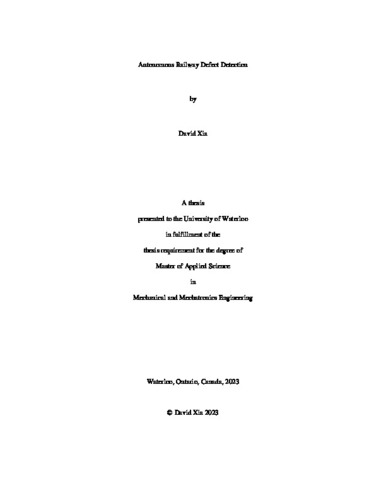UWSpace will be migrating to a new version of its software from July 29th to August 1st. UWSpace will be offline for all UW community members during this time.
Autonomous Railway Defect Detection
| dc.contributor.author | Xia, Yuwei | |
| dc.date.accessioned | 2023-04-27 15:34:27 (GMT) | |
| dc.date.available | 2024-04-27 04:50:04 (GMT) | |
| dc.date.issued | 2023-04-27 | |
| dc.date.submitted | 2023-04-26 | |
| dc.identifier.uri | http://hdl.handle.net/10012/19345 | |
| dc.description.abstract | Railway defects can lead to enormous economic and human losses. Among all types of the defects, surface defects are the most common and prominent. Although various non-destructive methods can be used to detect railway defects, optical inspection is considered the most suitable for surface defects. The aim of this project is to utilize the commercial drones as a platform for conducting visual inspections. The project is divided into two parts: flight control of the drone and the development of an algorithm to identify defects. For the flight control of the drone, two methods are proposed: pre-set flight path and the real-time track tracing. The pre-set flight path is the simplest approach because it is a built-in function of the drone. However, it is heavily dependent on the GPS coordinate system, which can be problematic in areas with weak GPS signals. The real-time track tracing, on the other hand, requires the development of an algorithm to locate the railway track. This can be achieved through either pattern matching or edge detection. Of the two methods, edge detection is more promising since it produces more consistent result and can be achieved by incorporating various image filters. Numerous attempts have been made to use optical-based non-destructive testing (NDT) methods for detecting railway defects. However, reliable and accurate interpretation of the test data is crucial in the NDT practice. There are many sources of errors that can negatively impact the results of NDT, with human errors being the most unpredictable and frequent. The introduction of artificial intelligence (AI) has the potential to address this problem, but the lack of sufficient railway images with various types of defects is the major obstacle to training the AI models through supervised learning. To address the issue of data scarcity, RailGAN model is proposed in this research. The RailGAN model can improve upon the basic CycleGAN model by incorporating an additional pre-sampling stage for railway tracks in the algorithm. Two pre-sampling techniques are tested for the RailGAN model: image-filtration and U-Net. By applying both techniques to 20 real-time railway images, it is demonstrated that U-Net can produce more consistent results in image segmentation across all images while being less affected by pixel intensity values of the railway track. The application of the RailGAN model implemented with U-Net and the original CycleGAN model to the same real-time railway images shows that the original CycleGAN model generates defects in the irrelevant background, whereas the RailGAN model adds synthetic defect patterns only on the railway surface. The defective images generated by RailGAN iv model closely resemble real cracks on the railways and can be used for training neural network-based defect identification algorithms. The proposed solution for defect identification involves the use of the YOLO network, which can detect and localize defects in the images. It is trained using the generated defective railway images and their corresponding labels. Testing the algorithm on 10 images available online, the YOLO-v5 algorithm can identify 90% of all defects in the images. However, there are still future works that need to be accomplished. For the drone flight control, the algorithm will need to be written in the JAVA language using the mobile SDK. Regarding defect detection, RailGAN will generate a larger amount of images, and the YOLO network will be trained with a larger dataset. The model will also be saved as a JSON file and implemented in the mobile SDK to enable real-time defect detection in the future. | en |
| dc.language.iso | en | en |
| dc.publisher | University of Waterloo | en |
| dc.subject | railway defect detection | en |
| dc.subject | dataset generation | en |
| dc.subject | autonomous flying drone | en |
| dc.title | Autonomous Railway Defect Detection | en |
| dc.type | Master Thesis | en |
| dc.pending | false | |
| uws-etd.degree.department | Mechanical and Mechatronics Engineering | en |
| uws-etd.degree.discipline | Mechanical Engineering | en |
| uws-etd.degree.grantor | University of Waterloo | en |
| uws-etd.degree | Master of Applied Science | en |
| uws-etd.embargo.terms | 1 year | en |
| uws.contributor.advisor | Kwon, HJ | |
| uws.contributor.affiliation1 | Faculty of Engineering | en |
| uws.published.city | Waterloo | en |
| uws.published.country | Canada | en |
| uws.published.province | Ontario | en |
| uws.typeOfResource | Text | en |
| uws.peerReviewStatus | Unreviewed | en |
| uws.scholarLevel | Graduate | en |

